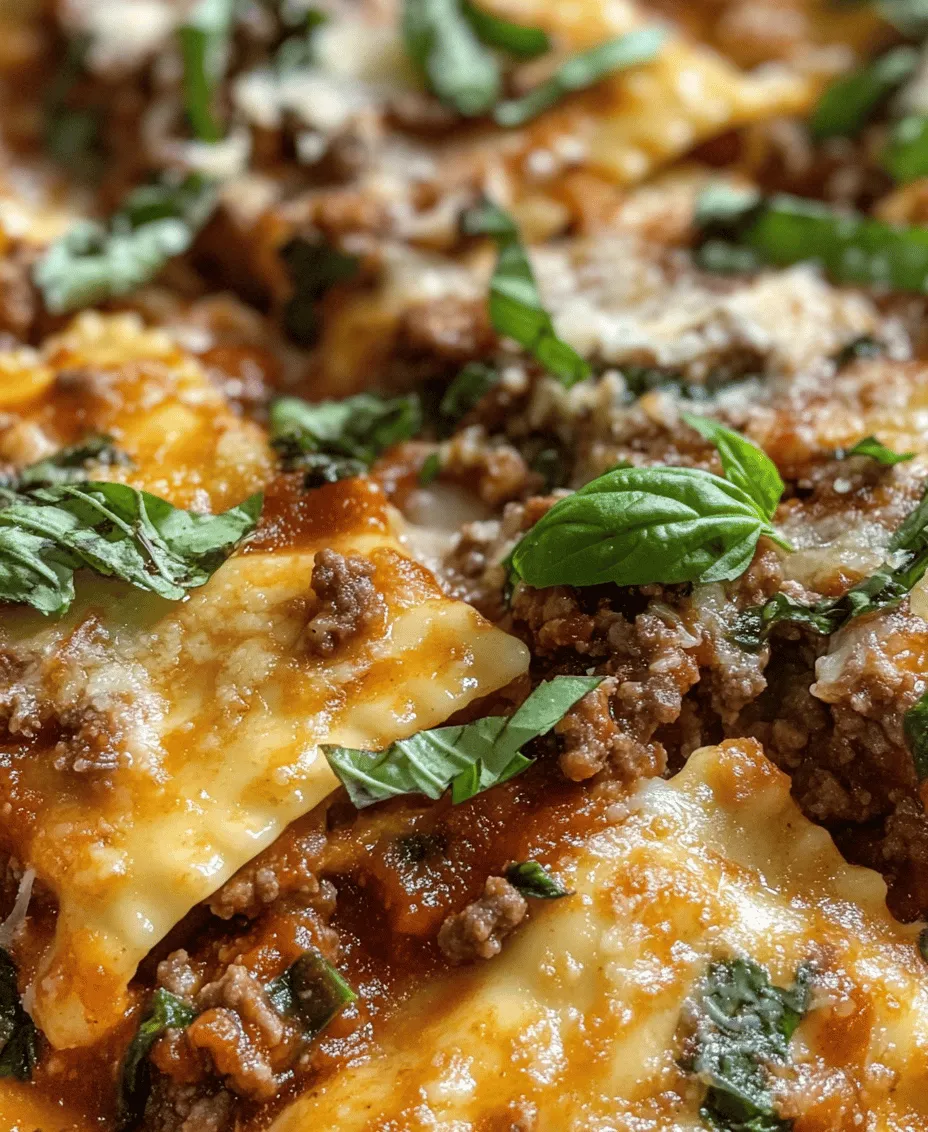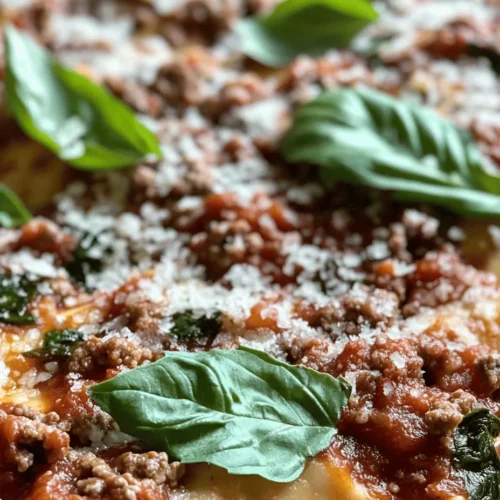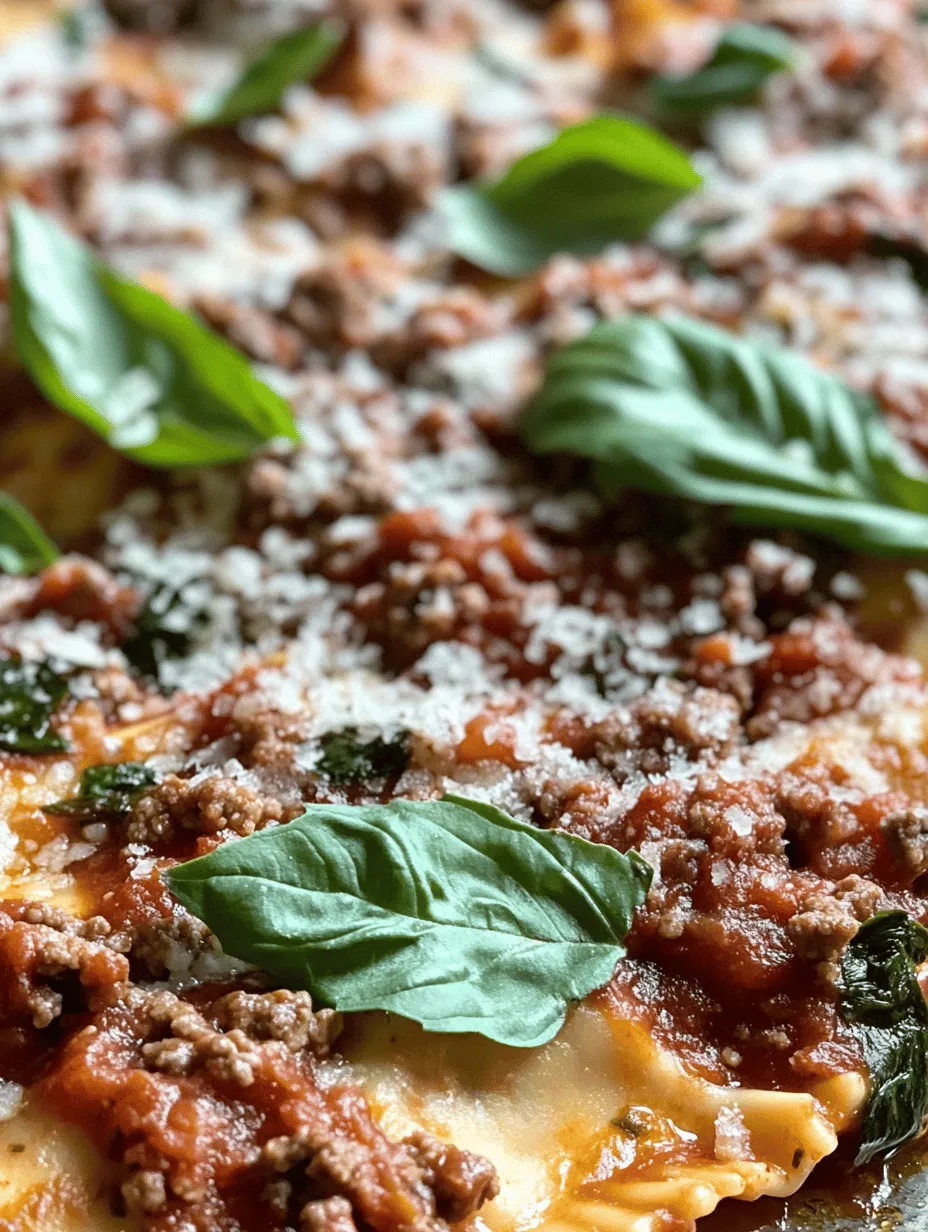Introduction
Savory beef ravioli with creamy ricotta spinach filling is a delightful dish that marries rich flavors with comforting textures. This Italian classic stands out for its handmade pasta, which encapsulates a hearty filling of ground beef, fresh spinach, and creamy ricotta. Unlike store-bought versions, homemade ravioli offers a unique culinary experience that allows you to control the quality and freshness of your ingredients. The process of crafting these little pockets of goodness is not only rewarding, but it also brings a personal touch to your cooking, making each bite a reflection of your effort and care.
Creating food from scratch has numerous benefits, especially when it comes to dishes like ravioli. First and foremost, it allows you to customize the flavors and textures to suit your preferences. You can experiment with different fillings, sauces, and spices, ensuring that your ravioli is exactly how you want it. Moreover, cooking from scratch is often a healthier option, as it eliminates preservatives and unnecessary additives commonly found in pre-packaged products. Additionally, the act of making pasta can be a wonderful bonding experience for families, as it encourages teamwork and creativity in the kitchen. Whether you’re preparing a hearty family dinner, hosting friends, or celebrating a special occasion, this savory beef ravioli is sure to impress.
Understanding the Ingredients
To make savory beef ravioli with creamy ricotta spinach filling, the quality and freshness of your ingredients are paramount. Each component plays a crucial role in the overall flavor profile and texture of the dish.
Key Ingredients
1. Pasta Dough Components: The foundation of any ravioli lies in its pasta dough. The primary ingredients include:
– Flour: All-purpose flour is commonly used, but you can opt for ’00’ flour for a silkier texture. It’s important to choose a high-quality flour that will yield a smooth, pliable dough.
– Eggs: Fresh eggs contribute richness and color to the pasta, helping to bind the flour and create a tender yet robust dough.
– Salt: A pinch of salt enhances the flavor of the pasta, making it more palatable.
– Olive Oil: While optional, a drizzle of olive oil can add a subtle richness to the dough and help with its elasticity.
2. Filling Ingredients: The filling for the ravioli is where the dish truly shines. Here are the key components:
– Ricotta Cheese: This creamy cheese provides a luscious texture and mild flavor that balances the heartiness of the beef.
– Spinach: Fresh or sautéed spinach not only adds a vibrant color but also packs a nutritional punch, offering vitamins and minerals. Its slightly earthy flavor complements the other ingredients beautifully.
– Ground Beef: The star protein of the filling, ground beef brings a savory depth to the dish. Opting for lean beef ensures a balanced richness without excess greasiness.
– Parmesan Cheese: Grated Parmesan adds a layer of depth and umami flavor. It enhances the overall richness of the filling and contributes to a more complex taste.
3. Sauce Considerations: The sauce you choose to pair with your ravioli can elevate the dish even further. A classic marinara sauce, whether homemade or store-bought, offers a tangy contrast to the rich filling. Alternatively, a simple garlic and olive oil sauce can allow the flavors of the ravioli to shine.
Preparing the Pasta Dough
Making the perfect pasta dough is a fundamental skill in creating delicious ravioli. Follow these steps to ensure your dough is smooth and elastic, ready to be filled:
1. Creating the Dough Well: On a clean work surface, mound your flour and create a well in the center. This well will hold your wet ingredients, so it’s crucial to make it deep enough to contain the eggs without spilling.
2. Mixing Techniques: Crack your eggs into the well and add a pinch of salt and a drizzle of olive oil if desired. Using a fork, gently whisk the eggs, gradually incorporating the surrounding flour. Start from the inner rim of the well, pulling flour into the eggs until the mixture is too thick to mix with a fork.
3. Kneading the Dough: Once the dough has formed, it’s time to knead. Lightly flour your work surface and begin to knead the dough with your hands. Press down and fold the dough over itself, turning it a quarter turn after each fold. Continue kneading for about 8-10 minutes, or until the dough is smooth and elastic. This step is critical to develop gluten, which gives the pasta its structure.
4. Resting the Dough: After kneading, wrap the dough in plastic wrap and let it rest at room temperature for at least 30 minutes. Resting is essential as it allows the gluten to relax, making it easier to roll out later.
5. Tips for Working with Pasta Dough:
– Keep your work surface and hands lightly floured to prevent sticking.
– Avoid overworking the dough, as this can lead to tough pasta.
– If the dough feels too dry, a few drops of water can help; if it’s too sticky, add a little more flour.
Crafting the Savory Filling
Creating the filling for your savory beef ravioli is where you can truly customize the flavors to your liking. Follow these steps for a filling that is rich, creamy, and well-balanced:
1. Cooking the Beef: Start by heating a skillet over medium heat. Add a tablespoon of olive oil, and once hot, add the ground beef. Use a wooden spoon to break it apart, browning it evenly. Season with salt, pepper, and any additional spices you enjoy (such as garlic powder or Italian herbs). Cook until the beef is fully browned and no longer pink, about 6-8 minutes. Drain any excess fat if necessary.
2. Combining Ingredients: In a large bowl, combine the cooked ground beef, ricotta cheese, finely chopped spinach (which can be sautéed or raw based on your preference), and grated Parmesan cheese. Mix thoroughly until all ingredients are evenly distributed. The mixture should be thick and creamy, perfect for stuffing into your ravioli.
3. Adjusting Seasoning: Taste the filling and adjust the seasoning as needed. This is your chance to make it your own! You may want to add more salt, pepper, or even a pinch of nutmeg to enhance the flavors. Remember, the filling should be well-seasoned, as it will be encased in pasta.
Rolling and Cutting the Dough
Once your pasta dough has rested and your filling is prepared, it’s time to roll out the dough and cut it into ravioli shapes. This part can be both fun and artistic, as you shape the ravioli to your liking.
1. Techniques for Rolling Out Dough: Divide your rested dough into four pieces. Work with one piece at a time while keeping the others covered to prevent drying out. Using a pasta machine or a rolling pin, roll the dough out to about 1/16 inch thick. If using a pasta machine, start with the widest setting and gradually work your way to the thinnest.
2. Cutting the Dough: Once your dough is rolled out, lay it flat on your work surface. Using a sharp knife or a pastry cutter, cut the dough into squares or circles, depending on your desired ravioli shape. Place a small spoonful of filling in the center of each square or circle.
3. Sealing the Ravioli: To seal the ravioli, fold the dough over the filling, pressing the edges together to remove any air pockets. Use a fork to crimp the edges, ensuring a tight seal. This step is crucial to prevent the filling from leaking during cooking.
By following these steps, you’ll create a delightful dish that is perfect for any occasion. As we move forward, we will dive into additional tips for cooking your ravioli and pairing it with the perfect sauce to complete this exquisite meal.

Using a Pasta Machine vs. Rolling Pin: Pros and Cons
When it comes to making fresh pasta for your savory beef ravioli with creamy ricotta spinach filling, the method you choose for rolling out your dough can greatly influence the final result. Both a pasta machine and a rolling pin have their advantages and disadvantages.
Pasta Machine
Pros:
– Uniform Thickness: A pasta machine allows for consistent thickness across the entire sheet, which is crucial for even cooking.
– Less Effort: It requires less physical effort, making it easier to roll out large quantities of dough.
– Faster Production: You can roll out pasta sheets quickly, which is especially useful when making multiple ravioli.
Cons:
– Space Requirement: Pasta machines can take up considerable counter space and may need to be stored when not in use.
– Cost: High-quality pasta machines can be an investment, making them less accessible for casual cooks.
Rolling Pin
Pros:
– Accessibility: Most kitchens already have a rolling pin, making it a convenient option without additional investment.
– Control: Using a rolling pin allows for more tactile feedback, letting you gauge the dough’s thickness manually.
Cons:
– Inconsistent Thickness: Achieving uniform thickness can be challenging, leading to uneven cooking and texture.
– More Physical Effort: Rolling out dough by hand can be labor-intensive, especially with larger batches.
Importance of Thickness: How It Affects Cooking and Texture
The thickness of your pasta is crucial for the overall texture and cooking time of your ravioli. Generally, ravioli dough should be rolled out to about 1/16 inch (approximately 1.5 mm) thick. Thicker pasta may result in a chewy texture, while thinner pasta may tear easily during assembly.
Cooking Time Considerations: Thicker ravioli will require a longer cooking time, which could lead to overcooking the filling. Conversely, thinner ravioli may cook faster but can become mushy if overboiled. Striking the right balance is key to achieving that perfect bite.
Cutting the Ravioli: Tools and Methods for Uniform Shapes
To create uniform ravioli, several tools and methods can be employed. Here are a few options to consider:
Tools for Cutting Ravioli
1. Ravioli Cutter Wheel: This wheel has a fluted edge that creates decorative borders while cutting through the dough.
2. Cookie Cutters: Round or square cookie cutters can be used to cut dough into uniform shapes. Just be sure to dust them with flour to prevent sticking.
3. Pasta Machine Attachment: Some pasta machines come with attachments that can cut the dough into specific shapes.
Methods
– Laying the Dough: After rolling out your pasta, lay one sheet on a lightly floured surface. Use a ruler to measure and mark where you’ll cut.
– Cutting: Whether you use a cutter wheel, cookie cutter, or knife, ensure you’re applying even pressure for a clean cut.
– Spacing: Leave enough space between each cut to prevent them from sticking together.
Creative Options for Filling Variations
While the classic filling of beef, ricotta, and spinach is delicious, don’t hesitate to experiment with different flavors. Here are a few creative filling ideas to inspire you:
1. Mushroom and Truffle Oil: Sauté mushrooms with garlic and herbs, then mix with ricotta and a dash of truffle oil for an earthy flavor.
2. Butternut Squash and Sage: Roast butternut squash until tender, mash it, and mix with ricotta and fresh sage for a sweet and savory filling.
3. Roasted Red Pepper and Feta: Blend roasted red peppers with feta cheese and herbs for a Mediterranean twist.
Assembling the Ravioli: Step-by-Step Assembly Process
Assembling ravioli can be a fun and rewarding process. Follow these steps to ensure beautiful, well-sealed ravioli:
Filling Placement: How Much is Too Much?
When placing filling on your pasta sheet, consider the following:
– Size: Use about a teaspoon of filling for small ravioli and up to a tablespoon for larger ones.
– Spacing: Leave enough space between each dollop of filling to ensure that you can seal the edges without any filling spilling out.
Sealing Techniques: Ensuring No Air Pockets and Avoiding Leaks
1. Moistening the Edges: Use a brush or your finger to moisten the edges of the pasta sheet with water. This helps seal the ravioli better.
2. Placing the Top Sheet: Gently lay another sheet of pasta over the filled one, pressing down around each mound of filling.
3. Removing Air Pockets: Carefully press around each filling to expel any air pockets, which can cause the ravioli to burst during cooking.
4. Sealing the Edges: Use a fork to crimp and seal the edges, ensuring a tight closure.
Decorative Edges: Enhancing Presentation with Crimping
Crimping the edges of your ravioli not only seals them but also adds an appealing decorative touch. Use the tines of a fork or a specialized ravioli cutter to create a fluted edge. This technique gives your ravioli a professional appearance.
Tips for Working Efficiently: Managing Time and Ingredients
– Prepare Ingredients Ahead: Have all your ingredients ready before you start assembling your ravioli. This includes your filling, pasta sheets, and any tools you’ll need.
– Work in Batches: If making a large quantity, work in smaller batches to keep your dough from drying out.
– Keep Dough Covered: Always cover your dough with a damp cloth as you work to prevent it from drying out.
Cooking the Ravioli: Best Practices for Cooking
Cooking your ravioli properly is essential for achieving the best flavor and texture. Follow these best practices:
Boiling Water: Importance of Salt and Temperature
1. Use Plenty of Water: Fill a large pot with water to allow the ravioli to cook evenly without sticking.
2. Salt the Water: Generously season the water with salt (about 1 tablespoon per liter) to enhance the flavor of the pasta.
3. Bring to a Rolling Boil: Ensure the water is at a rolling boil before adding the ravioli. This helps them cook evenly.
Cooking Time: Signs of Doneness
– Fresh Ravioli: Typically cook within 3-5 minutes. They are done when they float to the surface.
– Checking for Doneness: Test one ravioli by cutting it in half. The pasta should be tender but still have a slight bite (al dente).
Handling Cooked Ravioli: Preventing Sticking and Maintaining Presentation
– Use a Slotted Spoon: Gently lift the ravioli out of the water to avoid breaking them.
– Coat with Olive Oil: If not serving immediately, toss the cooked ravioli with a little olive oil to prevent sticking.
– Avoid Overcrowding: Cook in batches if necessary to ensure even cooking and prevent sticking.
Preparing the Marinara Sauce: Quick Guide to Warming Marinara Sauce
A rich marinara sauce is the perfect complement to your savory beef ravioli. Here’s how to prepare it:
Store-Bought vs. Homemade: Benefits of Each
– Store-Bought: Quick and convenient, store-bought marinara sauces often come with added seasonings and flavors that can save time.
– Homemade: Making your own sauce allows for complete control over the ingredients and flavor. Plus, it can be customized to your taste.
Flavor Enhancement Tips: Adding Herbs, Spices, or Additional Ingredients
To elevate your marinara sauce, consider adding:
– Fresh Herbs: Basil, oregano, and thyme can add depth and freshness.
– Red Pepper Flakes: For a bit of heat, add red pepper flakes to the sauce as it simmers.
– Garlic and Onion: Sauté minced garlic and onion in olive oil before adding the sauce for a flavor boost.
Serving Suggestions: Plating Techniques and Garnishing Ideas
Presentation is key when serving your savory beef ravioli. Here are some tips to elevate your dish:
Plating Techniques: Presentation Tips for a Visually Appealing Dish
– Layering: Start with a base of marinara sauce, then add the ravioli on top. This prevents the pasta from becoming soggy.
– Tilt the Plate: For an elegant presentation, slightly tilt the plate when placing the ravioli for a more dynamic look.
Garnishing Ideas: Fresh Basil, Grated Parmesan, and Additional Toppings
– Fresh Basil: Scatter torn basil leaves over the top for a pop of color and fresh flavor.
– Grated Parmesan: Finish with a generous sprinkle of freshly grated Parmesan cheese.
– Drizzle of Olive Oil: A light drizzle of high-quality olive oil adds richness and shine.
Pairing Suggestions: Ideal Sides, Salads, and Beverages to Complement the Dish
– Salad: A simple arugula salad dressed with lemon and olive oil pairs beautifully with the richness of the ravioli.
– Beverages: A glass of Chianti or a light, crisp white wine complements the flavors of the dish nicely.
Conclusion
Savory beef ravioli with creamy ricotta spinach filling is not just a delectable dish; it’s a versatile comfort food that can be tailored to suit any occasion. Whether you choose to make the pasta from scratch or opt for store-bought, the joy of creating these little pockets of deliciousness is an experience worth savoring.
This recipe encourages you to explore the art of homemade pasta and filling, offering a rewarding adventure in the kitchen. Each bite of these ravioli will remind you of the comfort and joy that cooking can bring, especially when shared with loved ones. So roll up your sleeves, gather your ingredients, and embark on this culinary journey that promises to create memorable meals and cherished moments. Enjoy the process and the delight of serving a dish that’s not only satisfying but also showcases your culinary skills.



